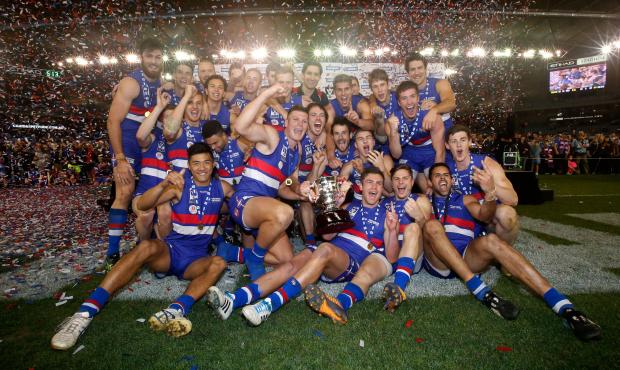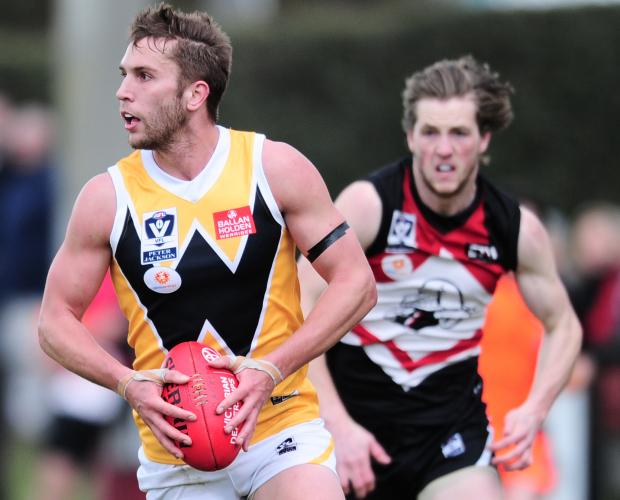ADELAIDE
Before last year, any Crows-listed player who wasn't selected to play in the AFL was sent back to an SANFL club. Exactly which club was decided by a mini-draft that took place shortly after the NAB AFL Draft. But it was a system that was increasingly fraught with issue. Players would sometimes be played out of their 'AFL' positions for their SANFL club's gain, or would rock up on game day with little to no knowledge of local game-plans. When situations soured between the two clubs, the player was sometimes moved to another SANFL side that had agreed to follow Adelaide's terms more closely. Then last year, the Crows were granted permission to field their own SANFL side – clearing all their issues. Players not selected to play AFL now play together in the SANFL, under the watchful eye of Crows coaches. – Harry Thring
Captains call for return of curtain-raisers
BRISBANE LIONS
The Lions have a reserves team in the NEAFL. The alignment has been in place since 1998, although it previously played in the AFLQ State League before the NEAFL's formation in 2011. The club aligns its reserves team with its seniors, allowing the senior coach to work in conjunction with the NEAFL coach (Shane Woewodin this year) to carry out his game-plan and put players in exactly the role he sees fit. The Lions have had good success at this level, winning the cross conference Grand Finals in 2012 and 2013, before bombing out last season to miss the finals. The one drawback of this format is injuries. The Lions rely on top-up players to fill the reserves team. They formerly had associations with local league teams to do this, but now turn to the club's Academy to fill the breach. Once underage commitments of the elite young talent take precedent, they then look to under-18 players from local to fill holes. It often leads to lopsided squads and lopsided results. – Michael Whiting
CARLTON
Although Carlton doesn't have its own VFL licence, the club essentially has full control over affiliate the Northern Blues. The clubs have been aligned since 2002 and have established tight links. Back in 2011, the then Northern Bullants voted to chance their nickname and this season the VFL team will adopt Carlton's guernsey. The teams share facilities at Ikon Park, while VFL coach Luke Webster is also a development coach for the AFL team and one of Carlton's directors, Greg Lee, now sits on the VFL club's board. When it comes to VFL match days, big brother has full control deciding players' roles. The Northern Blues have only been a middling side in recent years, finishing 11th, 9th, 10th and sixth since 2011. – Travis King
COLLINGWOOD
Collingwood ended its VFL affiliation with Williamstown at the end of the 2007 season, re-establishing its own reserves time at the start of 2008. The VFL Magpies play at Victoria Park, with reserve players joining those on the club's primary and rookie lists. Dale Tapping has coached the team since 2013, with input from development coaches Anthony Rocca and Tarkyn Lockyer. Tapping has led the team to elimination finals in each of his two seasons in charge. With so many talented young players on its list, Collingwood has placed a growing importance on developing its talent through the VFL program. Collingwood's VFL coverage is perhaps the best in the competition, with a live blog on the club's website keeping spectators informed about what is happening in each match and providing accounts on which players are performing well. At certain times, parents of players from interstate also check into the blog to see how their sons are travelling in a particular game. – Ben Guthrie
ESSENDON
The Bombers have fielded a standalone VFL team the past two years and will do the same again in 2015. The team has been coached by Hayden Skipworth, who has been able to work in a development role at Essendon while guiding its team through the state league. Although its foray into the VFL has not provided much success in terms of trophies, it has allowed Essendon to have full control over its players who are not in the senior team. Before it went alone, the club was aligned with Bendigo Gold, who formed to make the Bendigo Bombers. After Essendon chose to field its own team, Bendigo endured a tough run in the competitive league and the club disbanded. A number of Essendon VFL-listed players, like Aaron Heppell and Anthony Tipungwuti, got a taste of the top level in the NAB Challenge when they were signed as 'top-ups'. – Callum Twomey
Aaron Heppell, brother of Dyson, in action for Essendon's VFL side last season. Picture: AFL Media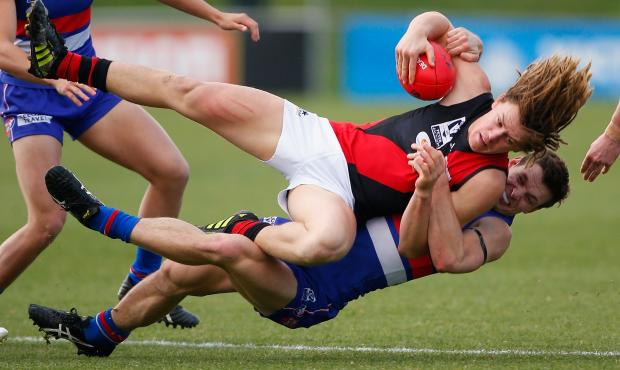
FREMANTLE
Ross Lyon said on 6PR on Monday that he saw Peel Thunder play its best game on Saturday since the alignment became entrenched in 2014. He said he finally saw Peel play the way the Dockers play. The WAFL alignment system has been controversial in WA football since the agreements were signed in 2012. In 2013, the Dockers' new recruits were sent to Peel while established recruits remained with their previous WAFL clubs. In 2014 all Dockers players were sent to Peel. The agreement is due to expire at the end of 2018. Peel's coach Cam Shepherd works at Fremantle one day a week. Dockers' head of development Simon Lloyd and some of the development coaches are also involved with Peel on game day. Senior Dockers players returning via the WAFL do have their minutes managed at Peel, but for the most part Peel has control of the rest, with some Dockers-listed players now playing reserves. The alignment with Fremantle was not met with as much animosity as West Coast's alignment with East Perth, due to Peel's poor record in the WAFL since entering the competition in 1997. The club has produced a lot of AFL players but has perennially struggled to be competitive at WAFL league level. – Alex Malcolm
GEELONG
Geelong has the advantage of having its own standalone VFL club where it can manage and select its players as it sees fit. The Cats' VFL team plays the same way as the AFL side, allowing the players who aren't up for senior selection to learn the club's structures and fill the roles they are projected to play when stepping up to the next level. Geelong's AFL program overlaps with its VFL program, allowing the club's coaching staff to develop its younger players and teach them the intricacies of the game. At times, the AFL-listed VFL players train with the other top-up players to develop cohesion and team unity. The other bonus is in the way the Cats can bring their more experienced players back through the VFL after injury. Josh Caddy and Allen Christensen were two Cats who spent time in the VFL last year as they worked on building match conditioning after long injury layoffs. The VFL Cats have been successful in their time in the state league, winning premierships in 2002, 2007 and 2012. – Ben Guthrie
GOLD COAST
Just like their rivals up the Pacific Highway, the Suns have a reserves team that plays in the NEAFL. This alignment has been in place since the club's inception in 2011, but has yet to bear any real fruit. With such a young list at senior level, it's often been a difficult task for the man in charge of the reserves, now Josh Fraser. Even at its strongest, the team is relatively inexperienced, but it hit farcical levels in 2014, when the Suns were decimated by injuries right throughout the club and went winless. For much of the season they had as few as eight or 10 listed players and relied on top-up players to fill their team. Aside from drawing players from its own Academy to do this, Gold Coast gets players from its nearest NEAFL club, Southport, who are not selected for that weekend. Not only were the Suns winless, it did little to develop the listed players who were unable to carry out a game-plan or structure with lesser skilled teammates. Gold Coast even decided to rush Zac Smith straight back to the seniors after a 12-month ACL injury rather than play him in the reserves, so little good did they think it would do. The Suns have gone about rectifying this by recruiting mature rookie talent in the off-season to bolster the reserves team. – Michael Whiting
GREATER WESTERN SYDNEY
The GWS reserves play in the North East Australian Football League and are coached by Brett Hand - the man who coached the Giants in 2011, the season before they entered the AFL. Having Hand in charge gives GWS coach Leon Cameron an important link to the players who don’t play AFL. Hand’s teaching background makes him an ideal coach for the young club. The NEAFL comprises teams based in Queensland (Aspley, Brisbane Lions reserves, Gold Coast reserves, Redland and Southport) and the Northern Territory (NT Thunder). There are also teams based in NSW (Sydney Swans reserves and Sydney University) and the ACT (Ainslie and Eastlake). The competition is heavily weighted towards the AFL feeder clubs - during the 18-game season the Giants play cross-town rivals the Swans four times, and as well as taking on the Lions and the Suns three times apiece. The Giants are known as the 'UWS Giants' in the NEAFL thanks to their affiliation with the University of Western Sydney. Since the NEAFL was formed in 2011, the Giants have made the finals in every season apart from 2012, but they’re yet to make the Grand Final. – Adam Curley
Cyril Rioli played three quarters of last season's VFL Grand Final for Box Hill. Picture: AFL Media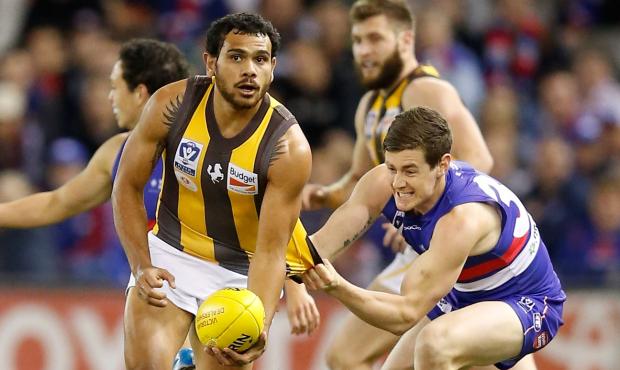
HAWTHORN
Established in late 1999, the Hawthorn-Box Hill relationship has been particularly profitable for both clubs during the mutual success of recent seasons. While Alastair Clarkson's squad has set the standard over the past two years, Box Hill has played in two Grand Finals and won the premiership in 2013. Any doubt about who is pulling the strings was cleared up in last year's VFL Grand Final. Ben McEvoy and Brad Sewell were pulled out on the day of the match, while Cyril Rioli – in his bid to play in the AFL Grand Final after 12 weeks sidelined by a hamstring – played three quarters but then watched the final term from the bench as Footscray overran the reigning premiers. Outside of its Hawthorn-listed players, Box Hill boasts a strong squad – one that outclassed a Northern Blues outfit featuring 13 Carlton players in a practice match on Good Friday – and should be a threat again in 2015. – Travis King
MELBOURNE
Melbourne has been affiliated with the VFL's Casey Scorpions since 2009. The alignment has had a somewhat turbulent history, with the Demons playing a dominant role in team selection and player management in recent seasons. However the clubs have sought to strengthen ties and the installation of VFL coach Justin Plapp is a major part of that. Former Demon and Cats premiership player Shannon Byrnes will be a playing assistant coach for the Scorpions, filling a key role in leading the club's younger players and reporting back to the senior coaching staff. As in recent seasons, the Demons have the capacity to bring back some of their experienced stars through the VFL competition. The return of midfielder Bernie Vince, who was given the opportunity to prove his fitness in a practice match at the weekend, is a case in point. Coach Paul Roos is also strong on the idea that players should earn senior games, meaning there are likely to be a number of Demons-listed players trying to force their way into the senior side while playing with Casey this season. – Ben Guthrie
NORTH MELBOURNE
North has enjoyed alignments with both North Ballarat and Werribee since 2008. In that time, the Roos have divided their players equally between their two affiliates, which has meant their developing players have almost always been able to play senior VFL football. However, North signalled late last year it would revert to a single alignment with Werribee from 2016, its decision to amicably part company with North Ballarat coming in the wake of the announcement the Western Bulldogs would play AFL games at the Roosters' home ground, Eureka Stadium, from as early as 2017. The Roos have enjoyed strong partnerships with North Ballarat and Werribee. Both clubs have been regular VFL finalists over the course of the alignments, with the Roosters winning three consecutive premierships from 2008-10. It is understood that when North's sole alignment with Werribee begins next season the Roos will be more involved in team selection, at training and on match days. Former North development coach John Lamont took over as Werribee coach in 2014 and is contracted until the end of 2017. – Nick Bowen
North's Jamie Macmillan in action for Werribee in the VFL. Picture: AFL Media
PORT ADELAIDE
Like Adelaide, until last year Port's unselected AFL players were fed out to a range of SANFL clubs despite the Power being born from the SANFL-based Magpies. While Port faced the same issues as the Crows in that its players had to learn different and sometimes contradicting styles, the system hurt Port's push to unite its SANFL and AFL bases. For instance, Aaron Young was an AFL player with Port Adelaide who played for North Adelaide in the SANFL; likewise Alipate Carlile – who played at South Adelaide. Like the Crows, Port would grow frustrated at SANFL clubs who played its players out of position and in turn SANFL clubs would grow angry at Port who might render their contracted players unavailable late in the SANFL season. Port Adelaide scored a huge win last year though when it was permitted to field its unselected AFL players in the Magpies, creating one united club that fielded teams in both competitions. – Harry Thring
RICHMOND
This will be the second season Richmond fields a standalone VFL team after being aligned to Coburg for 13 years. The Tigers joined Collingwood, Essendon, Geelong and the Western Bulldogs as clubs to feature their own VFL team, in a move made possible by financial contributions from the Fighting Tiger Fund. The money allowed for more resources for the club's second-tier players, ensuring they're playing in desired positions when not in the senior side. Coached by Tim Clarke, the younger Tigers will again have more support in the VFL season with recently retired players Andrew McQualter and Max Bailey among the assistant coaches. Recruitment for the VFL list is focused around the type of players Damien Hardwick wants playing the senior team's game style so the ones on the Richmond list benefit from solid teammates around them. The VFL Tigers finished 12th on the ladder in their first season with six wins, one draw and 11 losses, and will be captained this year by former Carlton-listed midfielder Jaryd Cachia. – Jennifer Phelan
ST KILDA
The Saints are entering their final season with VFL alignment club Sandringham, ending a partnership that started in 2009. St Kilda plans to establish a standalone VFL team from 2017 on, with the team to play out of a refurbished Moorabbin base. The partnership between St Kilda and the Zebras strengthened in 2012 when the Saints' academy manager Simon McPhee was appointed senior coach of the VFL team. Development coach Paul Hudson has since taken over the role, continuing a link that allows the Saints to have key personnel directing their AFL-listed players on match day. The coaching link is extensive, with development coaches Lindsay Gilbee and Peta Searle also working as assistant coaches with Sandringham. A key example of the alliance working well is Mav Weller's development as a tagger in the VFL last season. Weller excelled in run-with roles for a month at the start of the season, when he could have been used as a ball-winner. He earned senior selection as a tagger and is now in the Saints' leadership group. – Nathan Schmook
St Kilda's Arryn Siposs gets a handball away for Sandringham. Picture: AFL Media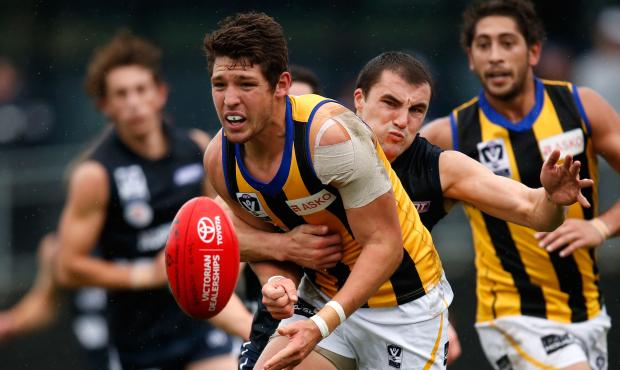
SYDNEY SWANS
Just like their cross-town rivals, the Swans reserves play in the NEAFL. They are coached by 2012 premiership player Martin Mattner while 2005 flag winner Jared Crouch is also part of the Swans' coaching staff. When the NEAFL was formed in 2011, the competition was split into the northern conference (Queensland and NT teams), and the Eastern Conference (sides from NSW and the ACT). That format was changed at the beginning of the 2014 season. Players from the Swans' academy help make up the rest of the side, with top-up players added from local clubs when they’re needed. Having their own reserves side gives the Swans control over their players, what positions they play and how much game time they see.The Swans came heartbreakingly close to a first NEAFL premiership last season, losing the decider to Aspley by two points. – Adam Curley
WEST COAST
The Eagles signed a controversial alignment with East Perth in 2012, and this has been a source of great frustration for other WAFL clubs. The Royals played finals in 2012 before the alignment began. They made the Grand Final in 2013 when the partial alignment was in place. In 2014 they played in the Grand Final with 10 listed Eagles players in the 22 but were beaten by Subiaco. Coach Brian Dawson is in consultation with the Eagles' development team, and development coaches Adam Selwood, Jaymie Graham and Mark Nicoski are involved on match-day. The alignment in game styles is not as close as Fremantle with Peel Thunder, as East Perth has a lot more WAFL/AFL experience throughout its wider squad. Like Peel, East Perth is prepared to play AFL-listed players in the reserves on merit, and at times this season as many as four listed players have played reserves instead of seniors. The alignment has caused much consternation for East Perth's rivals West Perth. The Falcons beat the Royals in the 2013 Grand Final, with Mark Hutchings, an Eagles-listed player, winning the Simpson Medal for best afield. But Hutchings was forced to move to East Perth the following season under the full alignment despite being a West Perth best and fairest winner in 2012. – Alex Malcolm
WESTERN BULLDOGS
If the Bulldogs win a AFL flag in the next few seasons, forming its own VFL team in 2014 is likely to be viewed as one of the cornerstones of the long-awaited triumph. The Dogs endured several challenging years aligned with Werribee and Williamstown during which they were left frustrated at the lack of control they had over what positions their charges played and at what level (VFL seniors or reserves). Having its own state league team has allowed the club to resurrect the Footscray name, bring footy back to the Whitten Oval and give its coach (Chris Maple in 2014 and Ashley Hansen in 2015) the freedom to develop players as they see fit. And the separation reaped immediate rewards, with youngsters including Mitch Honeychurch, Jason Johannisen, Michael Talia and Lin Jong emerging to be integral to the Dogs' march to last year's VFL flag. Those players now loom as important members of the campaign to give the Dogs' lone 1954 cup some long overdue company. – Ryan Davidson
Footscray celebrates its VFL premiership in 2014, featuring several Western Bulldogs. Picture: AFL Media